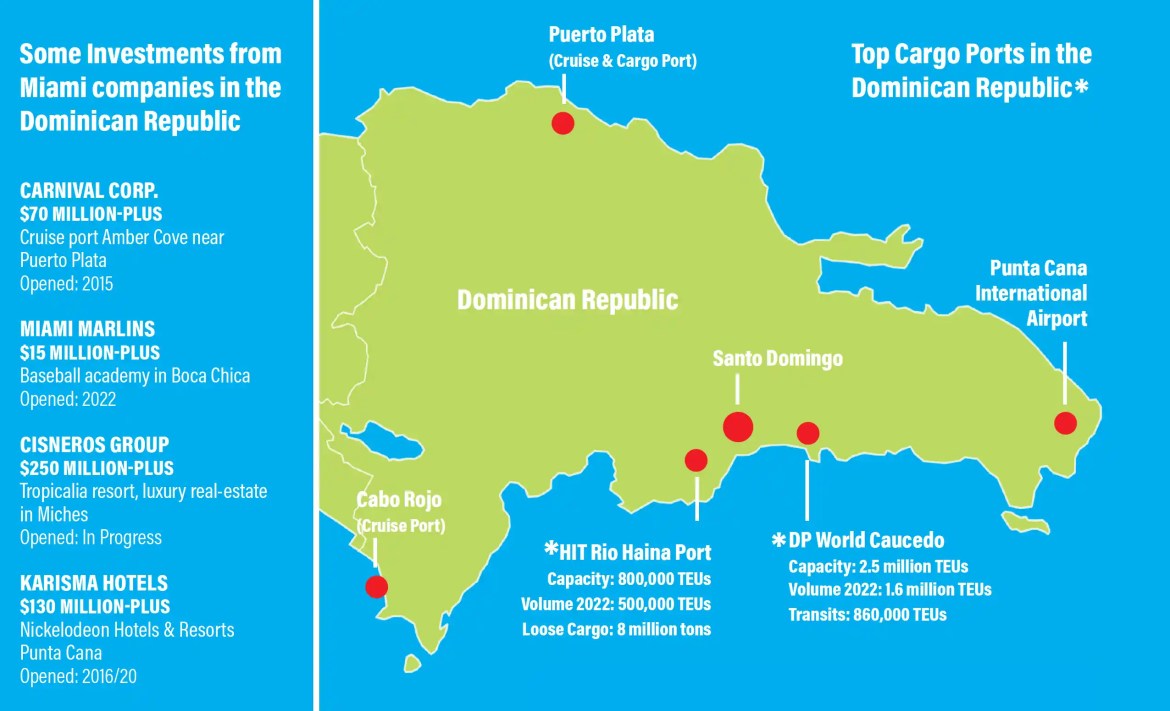
Dominican Republic’s main businesses
The Dominican Republic, located in the Caribbean, has a diverse economy with several key sectors driving its growth. Major industries include tourism, agriculture, free-trade zones (FTZs), mining, manufacturing, and real estate, with tourism being the most prominent. Let’s take a closer look at each of these main businesses:
1. Tourism
Tourism is the most significant economic driver for the Dominican Republic, contributing to over 10% of the country’s GDP. With its pristine beaches, luxurious resorts, and vibrant culture, the Dominican Republic attracts millions of visitors annually. Major tourist areas include Punta Cana, La Romana, and Puerto Plata. Visitors from North America and Europe make up a significant portion of the tourist population. The sector not only supports hotels and resorts but also benefits small businesses like restaurants, tour operators, and souvenir shops. The government invests heavily in infrastructure and tourism-related services to support this booming industry.
2. Agriculture
Agriculture has been a traditional economic pillar for the Dominican Republic. The country is one of the leading exporters of sugar, coffee, cacao, and tobacco. Bananas, rice, plantains, and vegetables are also essential crops. Cacao, in particular, is a growing segment, with the country exporting some of the world’s finest organic cacao. Agriculture employs a large part of the population, especially in rural areas, and remains vital for domestic food security. The government has also been promoting sustainable farming practices and investing in modernizing agriculture to increase productivity and export potential.
3. Free-Trade Zones (FTZs) and Manufacturing
The Dominican Republic has established itself as a competitive manufacturing hub, thanks to its numerous free-trade zones. These zones attract foreign companies with tax incentives and favorable trade conditions. The FTZs have become a significant source of employment and economic growth, hosting industries like textiles, electronics, pharmaceuticals, medical devices, and footwear manufacturing. The country has especially gained a reputation in the medical devices sector, exporting products worldwide. The United States is the main market for goods manufactured in these zones, owing to the Dominican Republic-Central America Free Trade Agreement (CAFTA-DR), which reduces trade barriers between the countries.
4. Mining
Mining has gained prominence as an essential sector in the Dominican economy. Gold and nickel are the primary minerals mined, with companies like Barrick Gold operating in the country. The Pueblo Viejo mine, one of the largest gold mines in the Americas, is a significant contributor to the economy. Mining is, however, a contentious issue due to environmental concerns. The government has been working on policies to ensure sustainable and responsible mining practices to balance economic growth with environmental preservation.
5. Real Estate and Construction
The real estate and construction sector has seen steady growth, largely fueled by foreign investment and the demand for tourism infrastructure, residential properties, and commercial spaces. Popular areas like Punta Cana, Santo Domingo, and Puerto Plata have attracted significant real estate development, including luxury resorts, vacation homes, and condos. This sector supports various construction-related businesses, including building materials, architecture, and project management. Increased tourism has also boosted demand for vacation rentals, adding further value to real estate investment.
6. Energy
As the Dominican Republic continues to grow, energy demand has increased, leading to investments in energy infrastructure. The government has worked to diversify the energy mix by encouraging renewable energy sources such as wind, solar, and hydropower to reduce dependence on imported fossil fuels. Several solar and wind energy projects have been developed to meet growing electricity demands, and the government aims to increase the share of renewables in its energy supply.
7. Financial Services
With the growth of various economic sectors, financial services have become increasingly important. Banks and financial institutions provide essential services like loans, insurance, and investment opportunities for businesses and individuals. The Dominican Republic’s financial sector is relatively stable, with several domestic and international banks operating. The growth of digital banking and fintech has also started to shape the future of financial services in the country, increasing accessibility to a broader population.
Conclusion
The Dominican Republic’s economy is diverse, with tourism, agriculture, FTZ-based manufacturing, mining, real estate, energy, and financial services being key contributors. While tourism remains the flagship industry, other sectors have expanded, providing stability and growth. The government is actively encouraging diversification and sustainable practices, positioning the Dominican Republic as an attractive business destination in the Caribbean. With continued investment, the country is likely to see further economic growth and development.



Leave a Reply